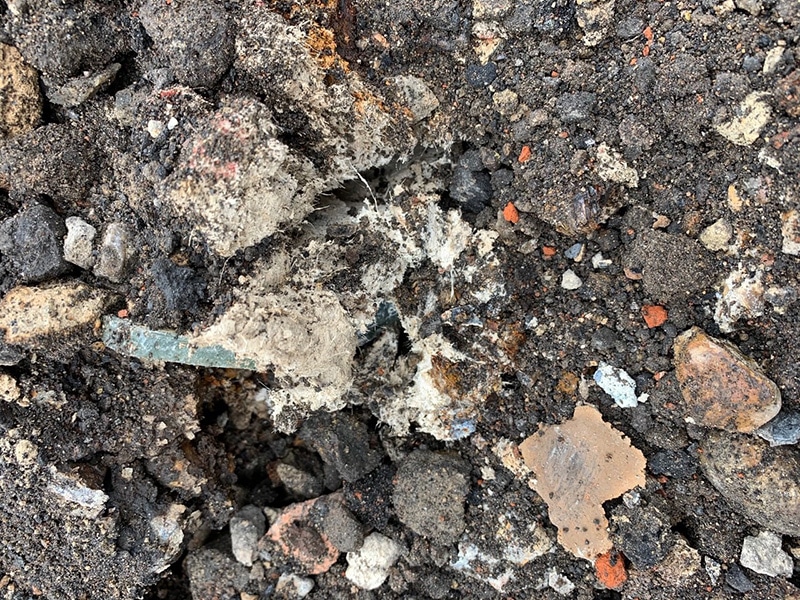What’s the difference between loose asbestos fibre and asbestos debris soil contamination?
Today, we know the risks of asbestos exposure. When asbestos fibres are inhaled and stick to the lungs, life-threatening diseases like lung cancer and mesothelioma can develop. It can take years for this to happen. Health issues due to asbestos exposure can arise decades later in a person’s life.
Asbestos is a category of naturally occurring minerals. Before its dangers were known, asbestos was used regularly in consumer and commercial products. Most commonly, asbestos was found in construction materials. Asbestos fibres are resistant to heat, making them useful for fire resistance in buildings.
When working with or around ACMs, it’s important to follow the correct safety measures. Protective equipment like respirators should be used. Additionally, follow the guidelines for handling and disposing of ACMs and refer to the Control of Asbestos Regulations 2012.
What is loose asbestos fibre contamination?
When asbestos is damaged, its fibres can release and become airborne. That’s when asbestos exposure is the most dangerous.
According to the UK government website, “Asbestos fibres do not dissolve in water or evaporate, they are resistant to heat, fire, chemical and biological degradation and are mechanically strong.”
Loose asbestos fibre contamination occurs when asbestos-containing materials (ACMs) are disturbed in some way, releasing individual asbestos fibres. Those fibres float around in the air and can be inhaled. They may also settle on a surface or get mixed in with soil.
For example, if a building is being remodeled and asbestos is disturbed in the process, fibres can get into the indoor air and be inhaled and swallowed by anyone working in the area.
Another example is loose fill asbestos, which is possibly the most dangerous type of ACM you can come across. This fluffy material was routinely used to insulate both commercial and domestic buildings. It’s often found between walls, under floors, and in lofts.
According to the Health and Safety Executive, “Loose fill is made up of pure asbestos.” If it’s disturbed, a large number of asbestos fibres can end up airborne.
The dangers of inhaling asbestos fibres
It’s easy to inhale small fibres without realising it. Here’s why:
- Asbestos fibres are tiny and lightweight, so they can stay in the air for a long time, even after work is finished for the day.
- Asbestos fibres are difficult to see with the naked eye.
- You may not realise that the damaged product contains asbestos.
When asbestos fibres are inhaled, they can get stuck in the lungs. This can potentially scar the lungs and lead to asbestosis, pleural thickening, or cancers. These diseases may have a worse outlook for people who had frequent exposure to asbestos. The size and shape of the fibres can also exacerbate health problems.
What is asbestos debris soil contamination?
Asbestos debris soil contamination occurs when ACMs end up on an outdoor surface, like in soil, along the roadside, or in waste dumps. The asbestos contamination could be on the surface or located more deeply in the material — for example, several layers down in the soil.
Soil can be contaminated by ACMs like insulation or roofing materials that deteriorate with time and end up mixed in with the earth or buried.
If the ACMs or contaminated land is disturbed, like when someone digs into the earth or even kicks up some soil when walking, asbestos fibres can become airborne. Even wind can cause asbestos fibres to float around, making it possible to inhale them. Here are more examples of how asbestos soil can be disturbed:
- Above-ground demolition
- Air sampling
- Excavations
- Ground improvements
- Ground surveys
- Installing a foundation
- Landscaping
Like with loose asbestos fibre contamination, when those fibres adhere to the lungs, major health problems can occur.
What is the difference between loose asbestos fibre and asbestos debris soil contamination?
There’s no such thing as a safe asbestos exposure event, and both loose asbestos fibre contamination and asbestos debris soil contamination carry high risks. Whenever asbestos is damaged, there’s the potential for fibres to release into the air.
One type of damaged asbestos is never really safer than another type of damaged asbestos. However, if there are fewer fibres released from one type than another, that may make the area less risky.
For example, loose fill asbestos that’s damaged during a building renovation will almost immediately release fibres. In this case, this type of asbestos has a higher risk than asbestos cement that’s found in soil. The asbestos cement probably won’t release as many dangerous fibres as the damaged loose fill asbestos.
On the other hand, we point out in this article that ACMs in soil have a higher chance of being damaged than ACMs in a building’s structure. Looking at it that way, asbestos soil can be considered the riskier of the two.
Ultimately, any presence of asbestos has the possibility of being damaged, which can release fibres that people may inhale. All types of ACMs should be handled carefully and taken seriously.
Different types of ACMs can end up in soil
Also consider that different ACMs, including those used in buildings, can end up in soil. The type of ACM determines how easily it releases fibres. For example, according to CL:AIRE, loose insulation “may readily become airborne if disturbed,” and it can be “easily damaged by repair work or accidental contact.” But with flooring, fibre release is only a concern if the material is cut or sanded.
If broken flooring ends up in soil, that can pose a problem in terms of fibre release. But fewer fibres may be present than with damaged loose fill asbestos.
Again, there’s no safe asbestos exposure event. However, knowing the risks and fibre release habits of different kinds of ACMs will help you determine how to work with them and if you need to hire a specialist.
Prevention and remediation
What should you do if you find ACMs that have or could release asbestos fibres? Or if you discover asbestos in soil? Follow these steps:
- Avoid exposure to asbestos fibres. If the ACM or soil has already been disturbed, you should leave the area to avoid inhaling any of the dangerous fibres.
- Prevent any activities that could further damage the asbestos. For example, restrict access to the area.
- Contact a professional asbestos consultant who can assess the situation and suggest the next steps to take. It’s important to understand the types of ACMs present and how much asbestos there is.
- Follow the expert advice you received — you’ll get a risk assessment and management plan.
If you’ll be handling the asbestos yourself, make sure to wear the appropriate gear and follow proper safety procedures. You may also have to have your staff trained on asbestos safety.
Final thoughts
The condition of the ACM, whether it’s in a building or in soil, determines how much of a danger it poses. All ACMs have the risk of being damaged or degrading with time, which can release health-threatening fibres.
In order to protect your own health and public health, you must understand how dangerous asbestos exposure is. The correct precautions must be taken to limit the risk of asbestos exposure as much as possible. Contact us today to speak with an asbestos removal professional.

Written by Mark Carter
Mark Carter is a renowned expert in asbestos management, offering clients vital guidance on compliance and safety. His expertise is invaluable for navigating asbestos regulations, ensuring both safety and legal adherence. Mark's role is central in providing effective asbestos-related solutions, helping clients achieve their business objectives with an emphasis on regulatory compliance and safety in asbestos management.

